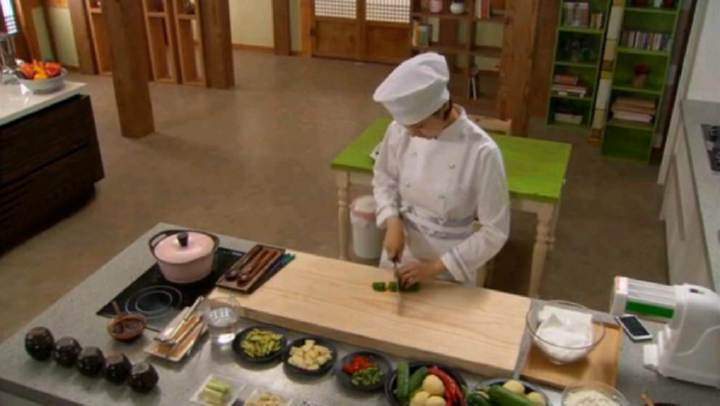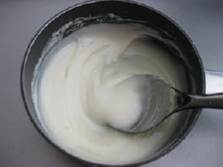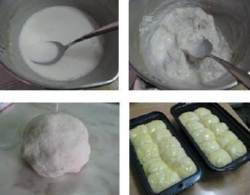
Bread Making Technique
There's so much to learn about in bread making. Asians, very
much prefer and enjoy softer and lighter breads. And that is why,
they have all kinds of fermentation method to keep the bread stay
soft and fluffy even after days. They are included as follow :
water roux
method, starter dough method, flour
gelatinised method (which adapted to Alex Goh, a famous
Malaysian Baker) and the
glutinous flour
gelatinised method for heavier loaf like whole meal bread
, multigrain bread.
Tangzhong Dough (
Water Roux )湯種
Tangzhong bread making was developed by the Chinese for a softer and
fluffy
bread. TangZhong method was originated from Japan. The most amazing
part is, the bread made with this method stays soft and fluffy even
after a few days. Simply reheat the slice of bread/bun in the
microwave for 10 to 15 seconds, you’ll have a warm, soft and fluffy
bun on hand, just like it’s fresh out of the oven.
Basically, the TangZhong method is to mix 1 part of bread
flour with 5 parts of water (by weight) at 65°C (149 °F) to form
a paste/wet dough. At 65°C, the gluten in the bread flour and water
mixture would absorb the moisture and become leavened. Thus, when
the TangZhong is added into other ingredients of a bread dough, it
will be heightened and produce fluffier bread
Ingredients:
500ml Boiling Water
100gm Bread Flour
Method
Whisk together the water and the flour until the mixture is well
blended and lump free.
Stir the mixture while it cooks over the medium heat to reach
65C/150F. It takes about 2-3 minutes., continue whisking until the
mixture starts to thicken up and remove immediately from the heat.
If you are continually stirring, the mixture will start to have
“lines ” (gluey and starchy) and then it is done
Transfer to a bowl and keep in the fridge for at least 1 hour and after completely cool down you can start
using it. Store the remaining starter in the refrigerator for up to
48hours, cover loosely with plastic wrap to prevent from drying
To use the starter, measure out the amount called for in a recipe
and let it warm to room temperature.
To convert normal recipe to tangzhong method:
Usually take out about 11-12 percent from the original recipe
bread flour recipe to make Tangzhong and add water ratio of 1:5
This starter must be used within three days.

Flour Gelatinised method
Ingredients:
100g bread flour
70ml hot boiling water
Method
1. Place Bread flour in a mixing bowl.
2. .Add hot boiling water and mix with wooden spoon to form a rough
dough..
3. Cover bowl with cling film and leave dough to cool in the fridge
for at least 1 hour or up to 48 hours
To convert normal recipe to flour gelatinised method:
Usually take out 1/4 portion of the original bread flour
recipe, then add about 70 per cent boiling water to this 1/4
portion.
Glutinous Flour Gelatinized Method
This is similar to Flour Gelatinized method except
glutinous rice flour is added. The bread made with this method has bigger air pockets suitable for heavy bread like whole meal or
multigrain bread.
Ingredients:
4 tbsp glutinous rice flour
糯米粉
6 tbsp water
3/4 cup bread flour
Method :
(1) combine glutinous rice flour and water, mix well.
(2) heat the mixture over low heat until thicken, off the heat
immediately once the mixture started to thicken and keep stirring
until it turns gluey and starchy.
(3) Stir in Bread flour gradually and mix to form a dough.
(4) then leave to cool before adding into the main ingredients.

Window pane
test for dough - under or over knead
In order for bread dough to rise properly you must
"develop" the gluten in the bread to give it the elasticity to hold
trap carbon dioxide given off as the yeast grows. That's what makes
bread rise.
If you manage to overwork the dough, the gluten can break down and
lose it's elasticity. The bread will not stretch as much, but some
of the bubbles will burst as the gas expands, and the bread will be
heavy.
However, if you are kneading bread by hand it's pretty close to
impossible to over-knead it. (Unless you are Hercules). It is common
however, for bread made by machines to be over kneaded.
So, how do you tell when the bread is well kneaded?
Gluten development is tested with the “windowpane test.” The Window Pane Test is an easy test to evaluate the readiness of
dough for bread while kneading.
Take a handful of dough and stretch it into a small sheet with your
fingers. The dough should stretch easily and smoothly, just like a
good piece of bubble gum just before you blow that bubble.
It's the same idea. You want a big elastic mass to trap the gas and
expand, containing the gas until baking makes the dough strong
enough to hold it's shape.
After the dough appears to be elastic, 10 minutes using an electric
mixer or 15 minutes by hand, Pinch off about two tablespoons of
dough and try to stretch it into a thin membrane (windowpane)
Slowly stretch the dough apart, alternating sides.
The goal is to stretch the dough until you can see light through it
without it tearing or ripping.
Once you can stretch the dough sufficiently, you can stop kneading.
1.If you can do so without tearing, but the membrane is still
mostly opaque, you have barely developed gluten.
2. If you can stretch a paper-thin, very translucent windowpane, the
gluten is fully developed.
3.A medium level is in between these two extremes: the windowpane is
translucent with some opaque areas.

Chinese Testing dough method.
The Chinese also has a simple method for testing the dough
readiness. Just pick up part of the dough and if the
balance of the dough follow through and does not fall back into the
mixing bowl or table the dough is ready. This method is used by the
Chinese when kneading for wheat noodles, la men etc.
The oven temperature affects both the
texture and look of the bread. How hot the oven temperature
determines how long it takes for the batter to set. The longer it
takes for the eggs, milk and flour to coagulate, the more time the
air cells in the batter have to grow larger and produce volume in
the dough. Too hot and the outer edges of the bread will set before
the middle has a chance to fully bake. This is why it is important
to have an accurate oven temperature. Having a free standing oven
thermometer in your oven will give you a proper reading on
temperature as some ovens are not calibrated properly.
The oven should always be preheated about 15 minutes before placing
the pans in the oven. If baking more than one layer at a time,
arrange the bread pans so they are about 2 inches (5 cm) apart and 2
inches (5 cm) from the sides of the oven. This ensures adequate air
circulation and promotes even baking. Do not open the oven door,
especially during the first 15 minutes of baking, as the oven
temperature drops about 25 degrees F every time the oven door is
opened.
Salt
Salt adds taste and strengthens the dough. Without salt, your bread
will taste very flat and lifeless.
Do not add salt directly to the yeast.The yeast will die and your dough will not
rise. Instead add the salt to the flour and other ingredients and
mix well before adding in yeast.
Water
Always make your dough using room temperature warm water. Too little
water and your dough will be too stiff and not very extensible. The
dough will not stretch out nicely when you flip. Too much water and
your dough will be too pliable and lack enough resistance. A
hydration level of about 60% is about right. (Hydration level =
Water weight/Flour weight X 100)
Milk Preparation
To prepare 1 glass of milk using milk powder
3 tablespoon or 33gm of milk powder to 200ml water
or 1tsp milk powder to 22ml water or 1 tablespoon water.
Condensed Milk (optional)
Replace it with 40mls of water and 1 tablespoon of Sugar, if you
omit the 1/4 cup of condensed milk
Milk adds a nice caramel flavour and sweetness to the dough. The
milk also tenderizes the dough and the sugar helps to caramelize the
bread to a nice brown colour.
Oil/Butter
Helps to give the bread a nice flavour and also in making the dough
more pliable. Oil acts like a leavening agent by getting in between
the gluten sheets; the more oil, the fluffier the bread
Oil may be omitted if you wish, the bread will a little less pliable and the taste will be a little flat
.
Egg
The egg proteins help to strengthen the gluten and makes the
flipping easier. The egg white helps make the dough more resilient
and the yolk contains lecithin which helps emulsify the oil. The egg
also adds more nutritional value to the dough.
Bread Improver
Bread improver adds texture and volume to the bread.
Bread improver is a mixture of enzymes usually ascorbic
acid (vitamin C) to improve the gluten function of your bread and to
accelerate the fermenting action of the yeast, enabling a better
quality of rise in, in a shorter period of time.
For 3 cups of flour, add about 1
to 1˝ tsp of bread improver or just add 1 tablet of vitamin C for
whatever size of loaf.
Bread Softener
Bread softener keeps the bread soft and moist., more commonly
referred to as the emulsifier, is an additive, for example
lecithin (an extract from the soy bean), which binds with the water
and fat in the dough, to stabilize the mixture. It improves crumb
and the slicing behavior of the bread, and enhances a sense of
freshness', i.e. the springiness of the finished bread.
For 250g of bread flour, add about 1/4 tsp of bread softener
will do.
Making the Dough tips
1.Mix water and flour evenly, leave it alone for 20 minutes
Giving it 15 or 20 minutes rest allows moisture to be absolved
before you
start to knead and you will get a smooth dough faster. Then knead
by hand for about 20 minutes with a 10 minutes rest time in between.
The longer you rest the dough the better. I find that by 50 mins
dough is extensible enough to be knead. If you leave your dough
overnight, you allow fermentation to take place and your dough will
have time to develop a full bodied flavour.
Lastly and most important is to choose and understand the correct
type of flour used for your bread.
Please see
Understanding
flour and the varies type of flour
before you start.
Back to Recipes Index
|



